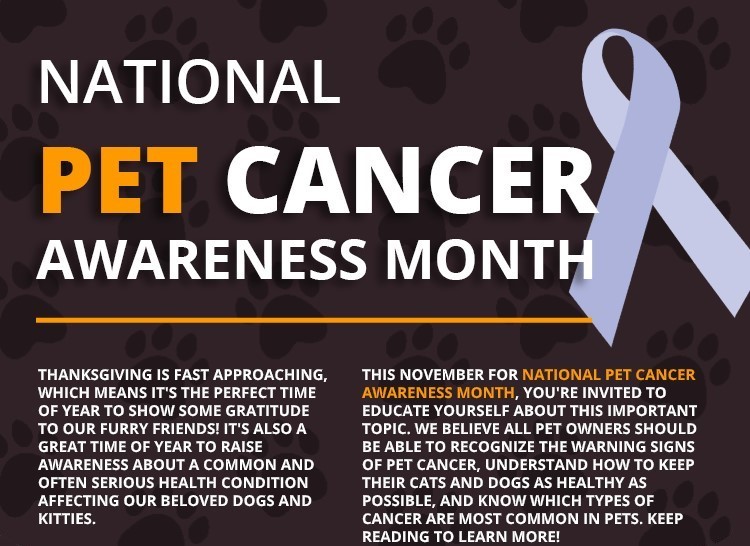November is Pet Cancer Awaresness Month

There are many things to recognize in the month of November. Besides Thanksgiving for the Americans and Bonfire Night for the English, November is a time to recognize those afflicted with disease. For pet lovers, November is a Pet Cancer Awareness Month. Since it is up to us to help our pets, we have to know how to recognize signs of pet cancer and how to help with prevention.
What Are the Facts About Cancer In Cats?
Every year, twelve million dogs and cats are diagnosed with some form of cancer. One in every five cats is affected by cancer. After age ten, the risk of cancer increases. Half of all animals over the age of ten die of some form of cancer.
On the plus side, there are advances in medical treatment to help animals with cancer live longer, fuller lives.
How Can I Tell If My Cat Has Cancer?
If you notice one or more of any of the following symptoms in your cat, a trip to the vet may be in order.
- Bumps, lumps or swelling of the lymph nodes
- Unexplained bleeding
- Bad breath
- Changes in behavior
- Frequent bouts of diarrhea or vomiting
- Severe Weight Loss
What Kind of Cancers are Cats Susceptible To?
Adenocarcinomas can develop in a cat’s gastrointestinal tract and are frequently accommodated by vomiting and diarrhea. It is often seen in older male cats, most commonly Siamese and Domestic Shorthair cats. Some cats may suffer oral cancer in the form of Feline Oral Cell Carcinoma. Middle aged cats, particularly Siamese, are apt to develop Mast Cell Tumors. Intact females may be infected by mammary gland tumors. One out of every three cases of malignant feline cancers are the result of lymphomas.
Younger cats are not immune to cancer. Acute leukemia often attacks cats younger than five. While vaccines are indeed vital and indispensable for guarding your feline friend from a host of communicable diseases, one uncommon adverse effect of vaccines is VAS tumors. These tend to develop at the vaccination site. A VAS may not show up right away. Symptoms could start anywhere from four months to over ten years later.
How Can I Reduce My Cat’s Chances of Getting Cancer?
There are no guarantees, of course, but there are some things you can do to reduce your cat’s chances of contracting cancer. Discuss these with your vet for more information and viable solutions.
- Have your cat spayed or neutered. Your cat cannot get uterine cancer if she has no uterus nor can she have ovarian cancer if she doesn’t have ovaries. The reduction in hormones also reduces her chances of contracting mammary cancer. Neutering a male guarantees no testicular tumors. This also lowers the risk of him developing perianal tumors.
- Do not expose your cat to carcinogens. UV radiation is bad for cats too, particularly light colored ones or breeds with very little fur. Shelter your cat from the hottest part of the day. Make sure she has plenty of shade. If you needed more reason to stop smoking, secondhand smoke is as bad for kitties as it is for people.
- Feed your cat a healthy diet. Antioxidants and vitamins are great, but you also need to keep track of what your cat doesn’t eat. Your cat does not need processed ingredients, sugar, or any other pro-inflammatory ingredients. Keep in mind that your cat’s dietary needs may change as she ages. Discuss your cat’s diet with your vet.
- Get your cat tested. If you detect it early, you can treat it early. Bring your cat to the vet for routine visits. Routine exams are crucial for detecting the early warning signs of cancer. This can also aid in detecting other health problems, particularly as your feline friend gets older.
Conclusion
Cancer is a very serious condition, whether for an animal of a human. We of course all want our beloved pets to live long and happy lives. Early detection is your best course of surviving such a malady. In many cases, cancer can be prevented by keeping your cat away from carcinogens such as excessive UV radiation and cigarette smoke. Feed your cat a healthy diet rich in vitamins and antioxidants while avoiding the sugars and processed foods that your cat does not need. For more information, consult this infographic.
Author: Mary Nielsen
Sources:
http://acfoundation.org/cancer-education/
https://www.msdvetmanual.com/special-pet-topics/cancer-and-tumors/causes-of-cancer
https://www.msdvetmanual.com/special-pet-topics/cancer-and-tumors/reducing-the-risk-of-cancer
https://fetchacure.org/resource-library/facts
https://www.avma.org/public/PetCare/Pages/Cancer-in-Pets.aspx
https://nationaldaycalendar.com/national-pet-cancer-awareness-month-november/
https://petcancerawareness.org/pet-cancer-signs-and-symptoms/






![Dj Scratch mixing some beats. 🎧 🎶 #Mewsic #KitNipBox
[via Instagram | @dharmacatnitiative]](https://www.kitnipbox.com/meow/wp-content/plugins/instagram-feed/img/placeholder.png)